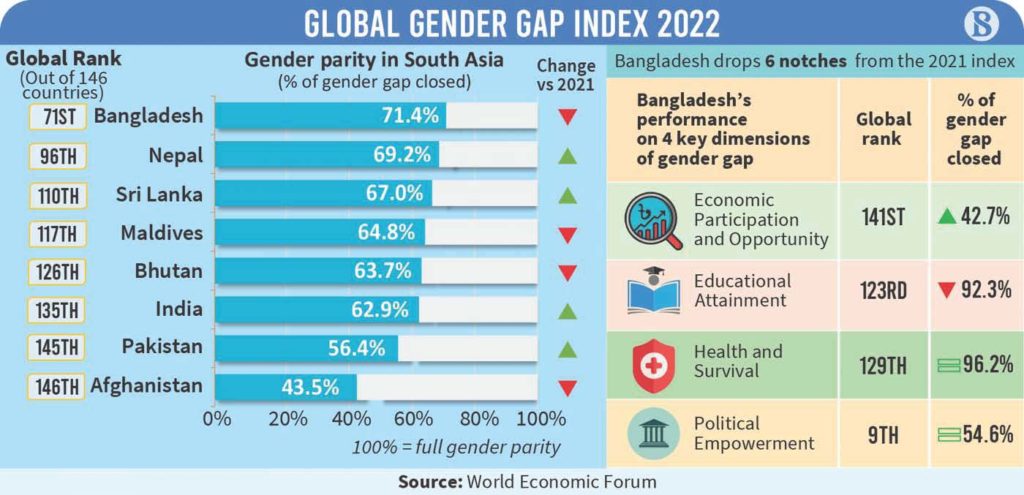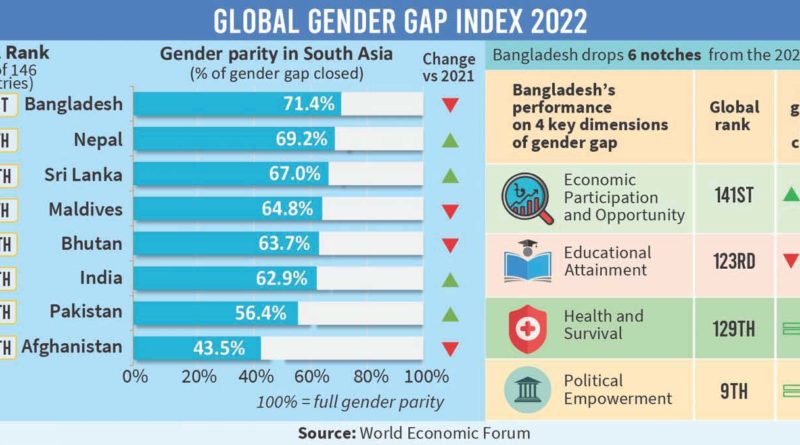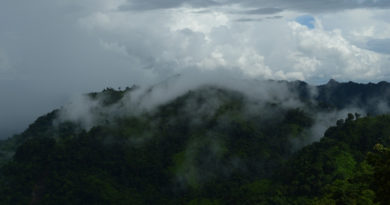Bangladesh most gender-equal country in South Asia
Bangladesh most gender-equal country in South Asia for 8th time
Despite being the best performer in the region, Bangladesh has fallen six notches to rank 71st among 146 economies
Infographic

Bangladesh has been named as the most gender-equal country in South Asia for the eighth consecutive year in the Global Gender Gap Report 2022.
The report of the World Economic Forum, released on Wednesday, said the country is the only one to have closed more than 70% of the gender gap among others in the region.
Despite being the best performer in the region, Bangladesh has fallen six notches to rank 71st among 146 economies surveyed in the 2022 index, which benchmarks countries based on how close they are to reaching gender equality.
The 16th edition of the report reveals that Bangladesh’s overall gender gap widened by 0.5 percentage points to 71.4% in 2022. As a result, its global position has deteriorated.
With 71.9% of the gender gap closed, Bangladesh was in the 65th position among 156 countries covered in the 2021 index.
However, Bangladesh has managed to stay ahead of all South Asian nations since 2014 by surpassing Sri Lanka that year.
“Bangladesh is comparatively doing well in gender parity. It has been outperforming other South Asian countries for a long time,” said Fahmida Khatun, executive director of the Centre for Policy Dialogue, one of the partner organizations of the Centre for the New Economy and Society of the World Economic Forum.
“If we look at Bangladesh’s performance in the major indices, we’ll notice that the performance is satisfactory,” she told The Business Standard.
Fahmida Khatun blamed Covid-19 for the low performance of Bangladesh in the case of educational attainment, one of the four key dimensions of the index.
According to the report, this year’s positions of South Asian countries in the regional ranking remained the same as that of 2021.
Nepal has the second-highest level of gender parity, currently standing at 69.2%. It has been ranked 96th.
Sri Lanka is the third-best performer in the region, with 67% of its gender gap closed. It has been placed at the 110th position on the index. It is followed by the Maldives at the 117th position and Bhutan at the 126th position.
India’s position on the index is 135th, third from the bottom in the region.
Afghanistan has been named as the least gender-equal country in the world and so in South Asia, with the gender gap closed by 43.5%. Pakistan stands 145th globally, being the second-worst performer in the region.
Although no country has yet achieved full gender parity, the top 10 economies have closed at least 80% of their gender gaps.
Iceland is the most gender-equal country in the world for the 13th time and the only one to have closed more than 90% of the gender gap, the report reads.
Other Scandinavian countries, Finland (86%, 2nd), Norway (84.5%, 3rd) and Sweden (82.2%, 5th), and New Zealand (84.1%, 4th) were featured in the top five.
The index benchmarks the current state and evolution of gender parity across four key dimensions – economic participation and opportunity, educational attainment, health and survival, and political empowerment.
Bangladesh’s performance on 4 key dimensions
The report highlights that Bangladesh’s declining performance can be attributed to slightly lower performance on educational attainment (123rd), a subindex with high concentration of scores near parity.
“A small drop in the gender gap score for literacy and the absence of recent data in primary education overshadow a slim increase of gender parity in tertiary education.”
Bangladesh registered no changes on political empowerment (9th) and health and survival (129th) indexes.
On economic participation and opportunity, the report said there was a reduction in both men and women’s workforce participation by 3.6 and 5.45 percentage points, respectively. However, the proportional impact was higher for women.
“The negative impact of this shortfall was nonetheless counteracted by a 5.3 percentage point increase in the share of women who are professional and technical workers, as well as a 13% increase in women’s estimated earned income (compared to men’s 11% increase), that raised parity outcomes overall.”
South Asia has the largest gender gap of all regions
South Asia (62.3%) has the largest gender gap among the eight regions covered in the report, with low scores across all measured gender gaps and little progress made in most countries since the last edition.
At its current pace, it is now expected to take 197 years to close the gender gap in the region.
The Middle East and North Africa (63.4%) has the second-largest gender gap yet to close, followed by Sub-Saharan Africa (68.7%), East Asia and the Pacific (69%), and Central Asia (69.1%).
Meanwhile, North America is the best performing region, with 76.9% of its gender gap closed. It is followed by Europe (76.6%), Latin America and the Caribbean (72.6%).




